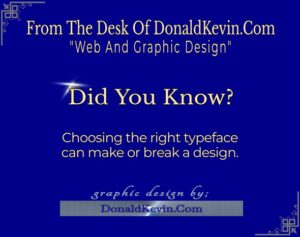Using Typeface
In this post, we’ll look at the evolution of typefaces and usage best practices. I hope you enjoy it.
____________________________________________________________________________________
The Printing Press and Communication:
The invention of the printing press in the 15th century changed the way we communicate forever.  It allowed for the mass production of books, newspapers, and other printed materials, making information more accessible to the general public. The printing press also led to the development of typography, which allowed for the creation of more elaborate and decorative typefaces. Today, typography is still an essential part of graphic design and plays a crucial role in communicating ideas and messages to the audience.
It allowed for the mass production of books, newspapers, and other printed materials, making information more accessible to the general public. The printing press also led to the development of typography, which allowed for the creation of more elaborate and decorative typefaces. Today, typography is still an essential part of graphic design and plays a crucial role in communicating ideas and messages to the audience.
Using Contrasting Typeface:
 Choosing the right typeface can make or break a design. One of the best ways to achieve a visually striking design is to use contrasting typeface. This approach involves using two different typefaces, each with a distinct style and character. When used effectively, contrasting typeface can help to create a strong visual hierarchy, add emphasis, and provide a unique personality to your design.
Choosing the right typeface can make or break a design. One of the best ways to achieve a visually striking design is to use contrasting typeface. This approach involves using two different typefaces, each with a distinct style and character. When used effectively, contrasting typeface can help to create a strong visual hierarchy, add emphasis, and provide a unique personality to your design.
Serif vs. Sans Serif Typeface:
Serif and sans serif typeface have been around for centuries and are still widely used today. Serif fonts are characterized by small lines or flourishes at the end of each letter stroke. They are often used for print materials such as books, newspapers, and magazines because they are easier to read in long-form texts. On the other hand, sans serif fonts are clean and modern, making them a popular choice for digital materials such as websites, apps, and social media.

The Difference Between Typeface and Fonts:
Have you ever wondered about the difference between font and typeface? 🤔 It’s a common confusion but they are actually two different things!
 A typeface is a collection of letters, numbers, and symbols that share a consistent design. For example, I’m using two types of typeface for this post. My heading is a Baskerville typeface with a 28-point bold font. My paragraph text is Montserrat (my favorite) using an 18-point regular font. So then fonts are specific styles and sizes within a typeface.
A typeface is a collection of letters, numbers, and symbols that share a consistent design. For example, I’m using two types of typeface for this post. My heading is a Baskerville typeface with a 28-point bold font. My paragraph text is Montserrat (my favorite) using an 18-point regular font. So then fonts are specific styles and sizes within a typeface.
Understanding this difference is important for designers and anyone who works with typography. Especially if you are a professional graphic designer. This is one of the fundamentals of graphic design. So, next time you’re working on a project, make sure to use the correct terminology.
When to Use Bold Fonts:
Bold fonts are often used to emphasize important information or to create a strong visual hierarchy. They can be used to highlight key phrases or words, create contrast, and add depth to a design. However, it is important to use bold fonts sparingly as overuse can diminish their impact.

When to Use Regular Fonts:
Regular fonts are the workhorse of graphic design. They are versatile and can be used for body text, headlines, subheadings, and more. Regular fonts are easy to read and can help to create a clean and balanced design. When selecting a regular font, it is important to choose one that is easy to read and complements the rest of the design.
In conclusion, typeface is an essential component of graphic design. By using contrasting typeface, understanding the difference between serif and sans serif, knowing when to use bold or regular fonts, and appreciating the impact of the printing press on communication, you can elevate your design skills and create truly impactful designs.
Thank you for visiting DonaldKevin.Com. I hope you found this informative and useful. It is my honor to have you here and I will do my best to bring you useful content and tools to enhance your design skills. Stay groovy and thank you!
_________________________________________________________________________________